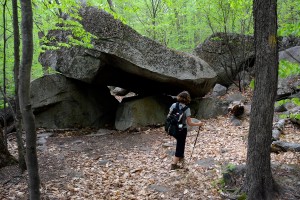For some reason I have failed to acknowledge the existence of hiking poles. Until now. It seems that everywhere I look this year, hiking poles pop onto my radar. As I speak with friends, expert hikers on unimaginably difficult terrain, I find that they are enthusiastic about their poles.
So, I went to work to see what I could learn and share the news with you. Of course, you may be way ahead of me, but if not, perhaps you will join me as I try hiking this fall using poles.
We will not be the first to do so. Consider this list of individuals often pictured with their walking sticks: Moses, King Tutankhamen, Louis XIV, Charlie Chaplin, Father Time, Old Man Winter and Dr. Gregory House (Hugh Laurie), to name but a few.
Hiking poles, two of them, look much like ski poles, usually collapsible, with a rubber or carbide tip, (sometimes baskets, but more on that later), and wrist straps on the handles. They are skinny and offer support but not the kind that invites leaning one’s entire weight on them.
Trekking poles, or hiking poles, seem to be most useful on irregular terrain where they offer stability and, by further engaging the upper body, help to alleviate fatigue to the lower body. Poles help the hiker to find a rhythm and to move forward and upward maintaining that rhythm. Once “in stride,” the hiker can touch the trail on either side and maintain an efficient, centered movement pattern that covers the trail with apparently less effort.
Poles increase confidence especially on tricky downhill segments, crossing streams and maneuvering among and around obstacles. Poles can be used to probe mud or water, help with balance across a log and, in some cases, even double as tent poles.
The learning curve for hiking with poles is short and easy.
Hiking with poles gets you outdoors and helps with balance and mobility. Poles protect your knees, ankles, hips and spine especially on downhills. Note that at the same time, being able to accomplish such descending safely acts as conditioning to strengthen muscles, tendons and even ligaments that support the important joints of the body.
Balance on the trails can be troublesome. Poles give that added touch that benefits equilibrium and creates the confidence to try for more.
It is one thing to walk forward and backward, up and down, but lateral movements often tip the scale of balance. It is here that poles are especially helpful.
Hiking is a repetitive motion and executing each stride with correct form and technique is imperative to improve strength and coordination, speed and balance, and to prevent injury. Hiking poles help to execute steps with the pace and alignment of a good gait. Poles may keep the hiker focused and motion fluid.
Perhaps one of the best things to be said about using hiking poles is that they expand opportunities for all types of hikers encouraging the advanced to reach higher goals and those with physical limitations to explore the outdoors with security.
There is little said in opposition. While some environmental concerns are raised such as the scratching of rock by the pole tips, holes left in the ground or baskets damaging fragile vegetation (thus basket removal is recommended unless hiking in snow or snowshoeing), adherence to the principles of “Leave No Trace” means that users can find ways to avoid leaving behind any type of damage. Awareness is usually the simple solution.
Adjusting poles to the proper height, slipping the hand up through the loop and easily wrapping the hand around the pole’s handle while resting weight on the loop, and picking up the alternating coordination of swinging arms with leg strides, are about the only training points.
In summary, it is interesting to see that the “Appalachian Trail Conservancy (ATC) estimates that pole usage rates on the Appalachian Trail vary from 90% among thru-hikers to 10-15% among day hikers.” (Saunders, Hipp, Wenos and Deaton, 2008). From what I have learned, I’ll just bet that 10-15% is much higher now, six years later. Shall we help to raise that percentage and join the trek?


